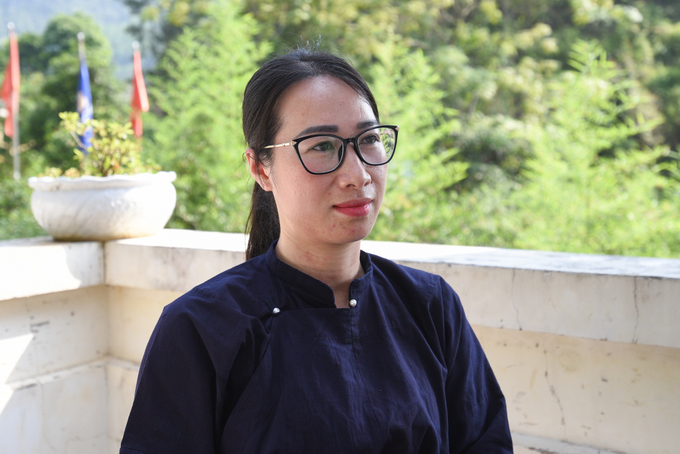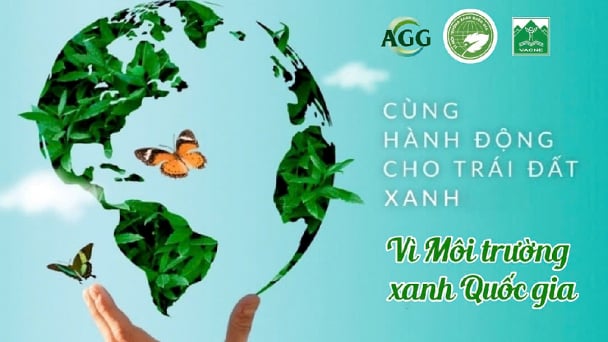May 18, 2025 | 02:48 GMT +7
May 18, 2025 | 02:48 GMT +7
Hotline: 0913.378.918
May 18, 2025 | 02:48 GMT +7
Hotline: 0913.378.918

The green jade-colored Quay Son river flowing through Ban Mom, where Thu was born and raised. Photo: Tung Dinh.
When we mention Cao Bang, many people immediately think of Ban Gioc, a majestic waterfall like a horizontal line falling from the sky, a symbol of Cao Bang's mountains. But when it comes to the beauty that is referred to as a "wonderland", we must talk about Quay Son river, the source of Ban Gioc.
Quai Son River is gentle, winding through the limestone mountains of Trung Khanh district, Ha Lang district with its green jade-colored water. The magical stream glides gracefully through the land of Cao Bang. There are places where it hugs the foot of the towering limestone mountain, in other places it is nestled under the green bamboo groves, or like a soft silk strip crossing the ripe rice fields.
Quay Son flows like how it was named, embracing the mountains, embracing the villages of the Tay, Nung in Cao Bang. And in Dam Thuy commune (Chong Khanh district), where Ban Gioc waterfall is located, there is a place that can't even be found on Google Maps. It is called Ban Mom, of the Tay people.

Nong Thi Thu, the Tay girl who has been engaged in tourism for more than 10 years in her hometown of Cao Bang. Photo: Tung Dinh.
Ban Mom is surrounded by the Quay Son river in front, leaning against the high cliffs behind. The terrain cannot be more beautiful. Perhaps because of that, this place was gifted with a Tay woman with a burning desire to do community tourism, named Nong Thi Thu.
Early summer. Cicadas tinkling near and far. In a small corner of a cafe in the campus of Saigon - Ban Gioc, the early morning sun slanted through the layers of willow leaves, dancing on the oval face with the bright eyes of Thu. Many people say that Tay women are both beautiful and talented. Perhaps this girl is a prime example.
As the first 9x generation, from a young age Thu has had a love for nature and her homeland. It was a vague feeling at first, then at the age of 18, when tourism began to develop in Cao Bang, Thu brought the thought "studying tourism might be easy to find a job" to Hanoi. And it was not just her love for the motherland, there was another motivation that helps her study hard. It was the hard work of farming, the days when she followed her mother to the rice and corn fields.

Thu often takes her delegations to experience the punctured mountains in Cao Bang. Photo: Tung Dinh.
In 4 years of university, Thu faced two options: English and Chinese. She chose the language of the neighboring country to study. The day she returned to Quay Son river, she wanted to do tourism but didn't know where to start. Despite having a bachelor's degree in tourism, she struggled to find a suitable path. "I learned Chinese, but I had little chance to practice with it and I didn't have any money at hand, so I decided to do some trading first," she said.
At that time, the border market, also known as the landmark 53 between Vietnam and China, was a bustling place. Accumulating a little capital after one year while improving her proficiency in Chinese, the daughter of Ban Mom once again packed things up and went to Hanoi, determined to take the exam and continue to study at graduate school. In 2015, Nong Thi Thu officially became a master in tourism, starting a new chapter in the story of bringing her homeland to international friends.
Thu’s mindset was “to go is to return”. She sought knowledge so that she would not struggle in the fields, but when she was done with her studies, she came back to her roots - Ban Mom’s land and mountains.
The time Thu studied at a graduate school was also when she started receiving the first tours. Slowly developing from the relationship with a Chinese business partner, she took tourists to explore famous destinations throughout the North. But since she was studying and working at the same time, the work was inconsistent.
Tours throughout the North with Chinese customers were put to a halt in 2020 when the Covid-19 pandemic broke out. This also marked a turning point in the tourism activities of this Tay girl. Difficulties in entry and exit between countries made Thu became more determined in narrowing down her area of operation, taking Cao Bang as the main area and switching from Chinese tourists to Western tourists. Because of that, this talented girl put on the effort to learn English herself.

The Tay female Master of Tourism helping two Australian tourists communicate and learn about travel information when they visited Dam Thuy commune, Trung Khanh district. Photo: Tung Dinh.
Since 2022 Thu's experience tourism activities is focused on trekking, motorbike and bicycle routes in beautiful places of Trung Khanh, Bao Lac, Nguyen Binh, Tra Linh (Cao Bang), Ba Be (Bac Kan), Mu Cang Chai, Meo Vac (Ha Giang). To ensure the convenience of each trip, Thu does her best to understand the needs of tourists before starting the journey. Some people like beautiful scenery, some like culture, some like life, and some like to experience it all.

Ancient villages like Phia Thap incense village of the Nung An people in Cao Bang left a deep impression on international tourists with Thu as an experienced guide. Photo: Tung Dinh.
“Mechanization is everywhere nowadays, so it is not easy to find a rudimentary farming spot for tourists to experience. I often take guests to the Nung village in Lung Phiac which still retains a lot of pristine features". Thu's voice mixed with the sound of Khuoi Ky stream as she slowly walked towards the village gate.
One lucky thing for this woman is that the people in the villages she passed through all had an awareness of tourism at a very early stage. They were ready to welcome and be friendly to all visitors. In turn, Thu also shared the benefits with every place she brought the tourist group to visit, trying to balance things out so that the whole community could reap the profits.
Born in the year of the horse, Thu roams on the path of tourism restlessly. When asked about marriage, Thu just replied "I haven't thought of it". A colleague of hers half-jokingly said, "Thu's biggest love right now is Mr. “Tourism”.

After many years of efforts, now the young director of Ban Mom Village Community Ecotourism Cooperative is having her own big plans in mind. Photo: Tung Dinh.
In the 4th "Rural Youth Innovative Startup Project Contest" held in Cao Bang province in 2021, Nong Thi Thu excellently won the top position with the project "Building a homestay model combined with community ecotourism development in Ban Mom".
Over the past 2 years, Thu's brainchild has been gradually developing, evidenced by the birth of the Ban Mom Village Community Ecotourism Cooperative with Thu as the director. This is expected to be a place for Thu and the Tay people in Dam Thuy to jointly develop tourism. Although the road ahead is still full of hardship, everyone believes that soon Ban Mom Village will be born in harmony with the tourist beat of Cao Bang.
Translated by Samuel Pham

(VAN) 14 out of 35 domesticated elephants in Dak Lak province have had their living conditions improved, with 11 of them currently participating in the non-riding elephant tourism model.

(VAN) Muong Nhe Nature Reserve hopes that being upgraded to a national park will lay the foundation for forest protection efforts to be carried out in a systematic, modern, and sustainable manner.
/2025/05/16/3923-2-171845_52.jpg)
(VAN) Lower costs, higher yields, and improved soil quality are outstanding benefits that soybeans bring when integrated into the crop rotation system.

(VAN) The 'For a Green National Environment' programme aims to promote a green lifestyle, support businesses in implementing ESG practices, and turn Net Zero commitments into concrete actions.

(VAN) Cold-barn systems efficiently manage environmental and temperature conditions, which aids in the prevention of respiratory diseases in pigs and protects them from the vectors that transmit African swine fevers.

(VAN) To tackle challenges, the project 'Addressing key technical bottlenecks in the grouper supply chain in Vietnam' has been underway since 2024.

(VAN) The project 'Disease-Resilient and Sustainable Cassava Production Systems in the Mekong Region', funded by the Australian Center for International Agricultural Research (ACIAR), is being implemented from 2024 to 2028.